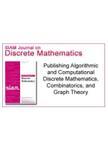版权所有:内蒙古大学图书馆 技术提供:维普资讯• 智图
内蒙古自治区呼和浩特市赛罕区大学西街235号 邮编: 010021

作者机构:Univ Chile DII Santiago Chile Paris Univ IRIF F-75205 Paris 13 France Paris Univ INRIA GANG F-75205 Paris 13 France
出 版 物:《SIAM JOURNAL ON DISCRETE MATHEMATICS》 (工业与应用数学会离散数学杂志)
年 卷 期:2021年第35卷第1期
页 面:55-90页
核心收录:
学科分类:07[理学] 0701[理学-数学] 070101[理学-基础数学]
基 金:ANR DESCARTES ANR ESTATE Inria GANG Inria DELYS MIPP Jose Correa Amazon Research award ANR HOSIGRA
主 题:graph classes graph algorithms vertex orderings with forbidden patterns
摘 要:This paper deals with the characterization and the recognition of graph classes. A popular way to characterize a graph class is to list a minimal set of forbidden induced subgraphs. Unfortunately, this strategy rarely leads to a very efficient recognition algorithm. On the other hand, many graph classes can be efficiently recognized by techniques that use some ordering of the nodes, such as the one given by a traversal. We specifically study graphs that have an ordering avoiding some ordered structures. More precisely, we consider structures that we call patterns on three nodes, and we study the complexity of recognizing the classes associated with such patterns. In this domain, there are three key previous works. Independently Skrien [J. Graph Theory, 6 (1982), pp. 309-316] and Damashke [Forbidden ordered subgraphs, in Topics in Combinatorics and Graph Theory, Physica-Verlag HD, 1990, pp. 219-229] noted that several graph classes, such as chordal, bipartite, interval, and comparability graphs, have a characterization in terms of forbidden patterns. On the algorithmic side, Hell, Mohar, and Rafiey [Ordering without forbidden patterns, in Algorithms-ESA 2014, Springer, 2014, pp. 554-565] proved that any class defined by a set of forbidden patterns on three nodes can be recognized in time O(n(3)) by using an algorithm based on an extension of 2-SAT. We improve on these two lines of works by systematically characterizing all the classes defined by sets of forbidden patterns (on three nodes) and proving that among the 22 different classes (up to complement) that we find, 20 can actually be recognized in linear time. Beyond these results, we consider that this type of characterization is very useful from an algorithmic perspective, leads to a rich structure of classes, and generates many algorithmic and structural open questions worth investigating.